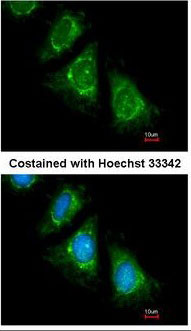PAN3 Antibody
Rabbit Polyclonal Antibody
- SPECIFICATION
- CITATIONS
- PROTOCOLS
- BACKGROUND

Application
| WB, IHC-P, IF, ICC |
|---|---|
| Primary Accession | Q58A45 |
| Reactivity | Human |
| Host | Rabbit |
| Clonality | Polyclonal |
| Calculated MW | 96kDa |
| Dilution | IF (1:100-1:200), IHC-P (10 µg/ml), WB (1:500-1:3000) |
| Gene ID | 255967 |
|---|---|
| Other Names | PAB-dependent poly(A)-specific ribonuclease subunit PAN3 {ECO:0000255|HAMAP-Rule:MF_03181}, PAB1P-dependent poly(A)-nuclease {ECO:0000255|HAMAP-Rule:MF_03181}, PAN deadenylation complex subunit 3 {ECO:0000255|HAMAP-Rule:MF_03181}, hPan3, PAN3 {ECO:0000255|HAMAP-Rule:MF_03181} |
| Target/Specificity | Human PAN3. Predicted cross-reactivity based on amino acid sequence homology: mouse (98%), bovine (83%). |
| Reconstitution & Storage | Aliquot and store at -20°C. Minimize freezing and thawing. |
| Precautions | PAN3 Antibody is for research use only and not for use in diagnostic or therapeutic procedures. |
| Name | PAN3 {ECO:0000255|HAMAP-Rule:MF_03181} |
|---|---|
| Function | Regulatory subunit of the poly(A)-nuclease (PAN) deadenylation complex, one of two cytoplasmic mRNA deadenylases involved in general and miRNA-mediated mRNA turnover. PAN specifically shortens poly(A) tails of RNA and the activity is stimulated by poly(A)-binding protein (PABP). PAN deadenylation is followed by rapid degradation of the shortened mRNA tails by the CCR4-NOT complex. Deadenylated mRNAs are then degraded by two alternative mechanisms, namely exosome-mediated 3'-5' exonucleolytic degradation, or deadenylation-dependent mRNA decapping and subsequent 5'-3' exonucleolytic degradation by XRN1. PAN3 acts as a regulator for PAN activity, recruiting the catalytic subunit PAN2 to mRNA via its interaction with RNA and PABP, and to miRNA targets via its interaction with GW182 family proteins. |
| Cellular Location | Cytoplasm, P-body {ECO:0000255|HAMAP- Rule:MF_03181, ECO:0000269|PubMed:14583602, ECO:0000269|PubMed:18625844} [Isoform 3]: Cytoplasm |
| Volume | 50 µl |

Thousands of laboratories across the world have published research that depended on the performance of antibodies from Abcepta to advance their research. Check out links to articles that cite our products in major peer-reviewed journals, organized by research category.
info@abcepta.com, and receive a free "I Love Antibodies" mug.
Provided below are standard protocols that you may find useful for product applications.
Background
Regulatory subunit of the poly(A)-nuclease (PAN) deadenylation complex, one of two cytoplasmic mRNA deadenylases involved in general and miRNA-mediated mRNA turnover. PAN specifically shortens poly(A) tails of RNA when the poly(A) stretch is bound by poly(A)-binding protein (PABP), which is followed by rapid degradation of the shortened mRNA tails by the CCR4-NOT complex. Deadenylated mRNAs are then degraded by two alternative mechanisms, namely exosome-mediated 3'-5' exonucleolytic degradation, or deadenlyation-dependent mRNA decaping and subsequent 5'-3' exonucleolytic degradation by XRN1. PAN3 acts as a positive regulator for PAN activity, recruiting the catalytic subunit PAN2 to mRNA via its interaction with PABP and to miRNA targets via its interaction with GW182 family proteins.
References
Ota T.,et al.Nat. Genet. 36:40-45(2004).
Dunham A.,et al.Nature 428:522-528(2004).
Uchida N.,et al.J. Biol. Chem. 279:1383-1391(2004).
Bechtel S.,et al.BMC Genomics 8:399-399(2007).
Funakoshi Y.,et al.Genes Dev. 21:3135-3148(2007).
If you have used an Abcepta product and would like to share how it has performed, please click on the "Submit Review" button and provide the requested information. Our staff will examine and post your review and contact you if needed.
If you have any additional inquiries please email technical services at tech@abcepta.com.













 Foundational characteristics of cancer include proliferation, angiogenesis, migration, evasion of apoptosis, and cellular immortality. Find key markers for these cellular processes and antibodies to detect them.
Foundational characteristics of cancer include proliferation, angiogenesis, migration, evasion of apoptosis, and cellular immortality. Find key markers for these cellular processes and antibodies to detect them. The SUMOplot™ Analysis Program predicts and scores sumoylation sites in your protein. SUMOylation is a post-translational modification involved in various cellular processes, such as nuclear-cytosolic transport, transcriptional regulation, apoptosis, protein stability, response to stress, and progression through the cell cycle.
The SUMOplot™ Analysis Program predicts and scores sumoylation sites in your protein. SUMOylation is a post-translational modification involved in various cellular processes, such as nuclear-cytosolic transport, transcriptional regulation, apoptosis, protein stability, response to stress, and progression through the cell cycle. The Autophagy Receptor Motif Plotter predicts and scores autophagy receptor binding sites in your protein. Identifying proteins connected to this pathway is critical to understanding the role of autophagy in physiological as well as pathological processes such as development, differentiation, neurodegenerative diseases, stress, infection, and cancer.
The Autophagy Receptor Motif Plotter predicts and scores autophagy receptor binding sites in your protein. Identifying proteins connected to this pathway is critical to understanding the role of autophagy in physiological as well as pathological processes such as development, differentiation, neurodegenerative diseases, stress, infection, and cancer.


